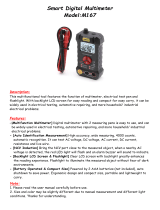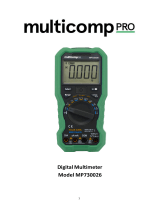
ii
SAFETY INFORMATION
Before any operations, please read the following safety precautions to avoid any
possible bodily injury and prevent damage to this product or any other products
connected. To avoid any contingent danger, use this product only as specified.
Limit operation to the specified measurement category, voltage, or
amperage ratings.
Do not use the multimeter if it is damaged. Before you use the
multimeter, inspect the case. Look for cracks or missing plastic. Pay
particular attention to the insulation surrounding the connectors.
Do not use the test leads provided for other products. Use only the
certified test leads specified for this product.
Inspect the test leads for damaged insulation or exposed metal.
Before use, verify the multimeter's operation by measuring a known
voltage.
Only the qualified technicians can implement the maintenance.
Always use the specified battery type. The power for the multimeter is
supplied with a battery. Observe the correct polarity markings before you
insert the batteries to ensure proper insertion of the batteries in the
multimeter.
Check all Terminal Ratings. To avoid fire or shock hazard, check all ratings
and markers of this product. Refer to the user's manual for more
information about ratings before connecting to the multimeter.
Do not operate the multimeter with the cover or portions of the cover
removed or loosened.
Use Proper Fuse. Use only the specified type and rating fuse for the
multimeter.
Do not operate if in any doubt. If you suspect damage occurs to the
multimeter, have it inspected by qualified service personnel before further
operations.
To avoid electric shock, do not operate this product in wet or damp
conditions.
Do not operate in an explosive atmosphere.
Keep product surfaces clean and dry.
Do not apply more than the rated voltage (as marked on the multimeter)
between terminals, or between terminal and earth ground.
When measuring current, turn off the circuit power before connecting the
multimeter in the circuit. Remember to place the multimeter in series with
the circuit.
When servicing the multimeter, use only the specified replacement parts.
Use caution when working above 60 V DC, 30 V AC RMS, or 42.4 V peak.
Such voltages pose a shock hazard.
When using the test leads, keep your fingers behind the finger guards on
the test leads.
Remove the test leads from the multimeter before you open the battery
cover.
To avoid false readings, which may lead to possible electric shock or
personal injury, replace the battery as soon as the low battery indicator
appears and flashes.





















